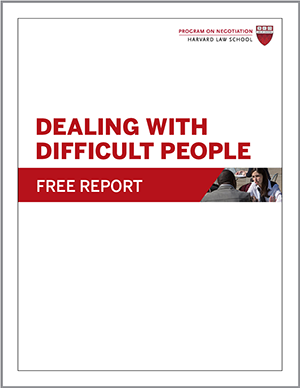
How do negotiators reach consensus in negotiated agreements while engaged in intense, often contentious, bargaining sessions with their counterparts? Here are some ways negotiators have reached consensus with colleagues and counterparts in the workplace.
Building Consensus for Your Negotiated Agreements
What do the following organizational changes have in common?
- A law firm adopts an automatic enrollment policy for its 401(k) retirement program. If employees want to unenroll, they must voluntarily opt out of the plan. Only a handful of employees drop out, and enrollment jumps from 70% to 99%.
- The new director of food services for a city school system moves desserts from the front to the back of the cafeteria lines and places fruit at eye level. Instantly, children begin to select more fruit and fewer desserts.
- A bank in the Philippines starts a program that encourages would-be nonsmokers to open savings accounts and, for six months, deposit the amount they would have spent on cigarettes. Customers who test clean for nicotine after six months get their money back; otherwise, the funds are donated to charity. The program achieves a higher smoking-cessation rate than the nicotine patch.
As you probably noticed, in each instance, individuals and organizations took steps to encourage others to make a beneficial choice—contributing more to retirement, eating better, and giving up smoking—that they might not otherwise have made.
In their book Nudge: Improving Decisions About Health, Wealth, and Happiness, Richard H. Thaler and Cass R. Sunstein make the case that just about anyone can become a “choice architect”: someone who, with a little creativity, nudges people to make smarter decisions for themselves. All of us are susceptible to biases that lead to flawed decisions, including overconfidence in our judgments, an irrational preference for the status quo, and many other cognitive mistakes we’ve covered in this newsletter. By anticipating how such biases will influence our decisions, we can set up systems designed to capitalize on them.
When automatic enrollment becomes the default choice for a retirement plan, for instance, most people will not make the effort to change from the status quo—and they will secure a much safer retirement than they would have otherwise.
Organizational decision makers would do well to build wise nudges into their negotiated agreements. If the U.S. government mandated an opt-out program for organ donation, for example, rather than the voluntary donation system in effect in most states, only those who truly objected to donation would make the effort to decline to participate. Many more donors would become available, and many more lives would be saved, argue Thaler and Sunstein. In your daily negotiations, you may be able to find creative ways to nudge those you’re responsible for to make better choices. You might adapt the Philippine bank’s antismoking campaign to your office, for example, and offer rewards to those who kick the habit.
What is your approach to negotiated agreements?
Related Dealing with Difficult People Article: Conflict Management and Negotiating When Pride is at Stake
Adapted from “A Nudge in the Right Direction,” first published in the January 2009 issue of Negotiation.
Originally published in 2013.





